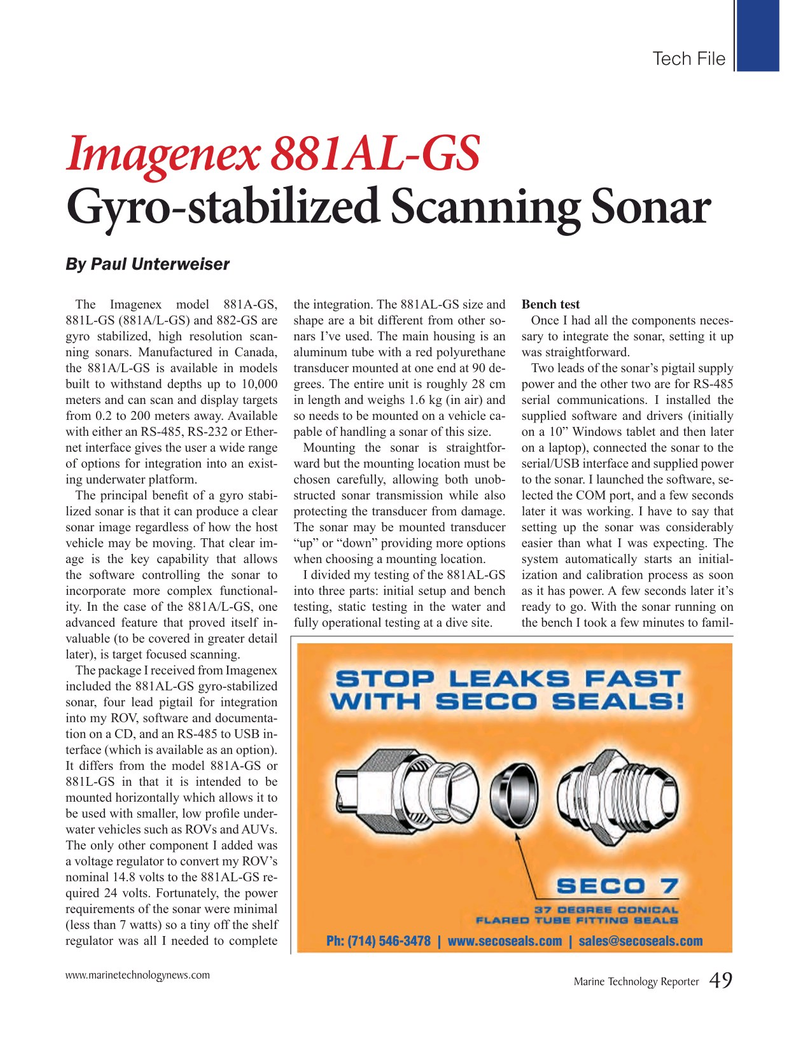
Page 49: of Marine Technology Magazine (September 2016)
Ocean Observation: Gliders, Buoys & Sub-Surface Networks
Read this page in Pdf, Flash or Html5 edition of September 2016 Marine Technology Magazine
Tech File
Imagenex 881AL-GS
Gyro-stabilized Scanning Sonar
By Paul Unterweiser
The Imagenex model 881A-GS, the integration. The 881AL-GS size and Bench test 881L-GS (881A/L-GS) and 882-GS are shape are a bit different from other so- Once I had all the components neces- gyro stabilized, high resolution scan- nars I’ve used. The main housing is an sary to integrate the sonar, setting it up ning sonars. Manufactured in Canada, aluminum tube with a red polyurethane was straightforward. the 881A/L-GS is available in models transducer mounted at one end at 90 de- Two leads of the sonar’s pigtail supply built to withstand depths up to 10,000 grees. The entire unit is roughly 28 cm power and the other two are for RS-485 meters and can scan and display targets in length and weighs 1.6 kg (in air) and serial communications. I installed the from 0.2 to 200 meters away. Available so needs to be mounted on a vehicle ca- supplied software and drivers (initially with either an RS-485, RS-232 or Ether- pable of handling a sonar of this size. on a 10” Windows tablet and then later net interface gives the user a wide range Mounting the sonar is straightfor- on a laptop), connected the sonar to the of options for integration into an exist- ward but the mounting location must be serial/USB interface and supplied power ing underwater platform. chosen carefully, allowing both unob- to the sonar. I launched the software, se-
The principal bene? t of a gyro stabi- structed sonar transmission while also lected the COM port, and a few seconds lized sonar is that it can produce a clear protecting the transducer from damage. later it was working. I have to say that sonar image regardless of how the host The sonar may be mounted transducer setting up the sonar was considerably vehicle may be moving. That clear im- “up” or “down” providing more options easier than what I was expecting. The age is the key capability that allows when choosing a mounting location. system automatically starts an initial- the software controlling the sonar to I divided my testing of the 881AL-GS ization and calibration process as soon incorporate more complex functional- into three parts: initial setup and bench as it has power. A few seconds later it’s ity. In the case of the 881A/L-GS, one testing, static testing in the water and ready to go. With the sonar running on advanced feature that proved itself in- fully operational testing at a dive site. the bench I took a few minutes to famil- valuable (to be covered in greater detail later), is target focused scanning.
The package I received from Imagenex included the 881AL-GS gyro-stabilized sonar, four lead pigtail for integration into my ROV, software and documenta- tion on a CD, and an RS-485 to USB in- terface (which is available as an option).
It differs from the model 881A-GS or 881L-GS in that it is intended to be mounted horizontally which allows it to be used with smaller, low pro? le under- water vehicles such as ROVs and AUVs.
The only other component I added was a voltage regulator to convert my ROV’s nominal 14.8 volts to the 881AL-GS re- quired 24 volts. Fortunately, the power requirements of the sonar were minimal (less than 7 watts) so a tiny off the shelf regulator was all I needed to complete
Ph: (714) 546-3478 | www.secoseals.com | [email protected] www.marinetechnologynews.com
Marine Technology Reporter 49
MTR #7 (34-49).indd 49 8/25/2016 2:43:11 PM

 48
48

 50
50
